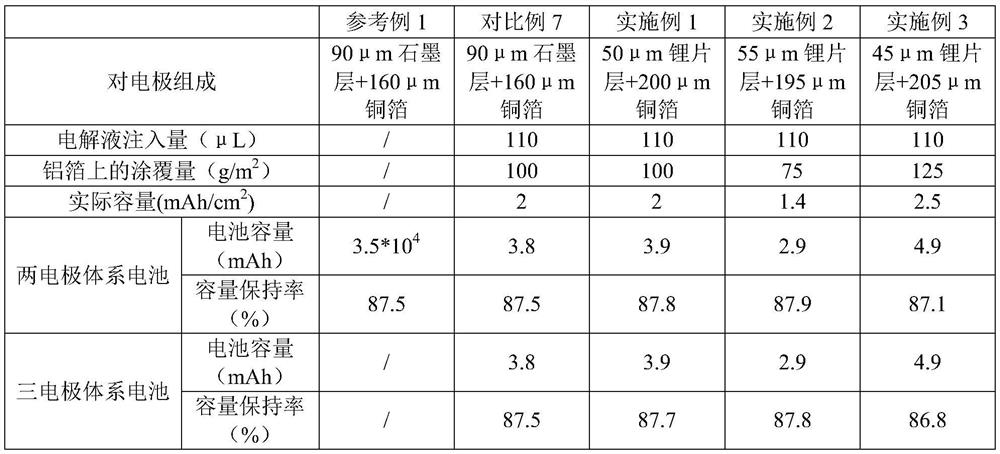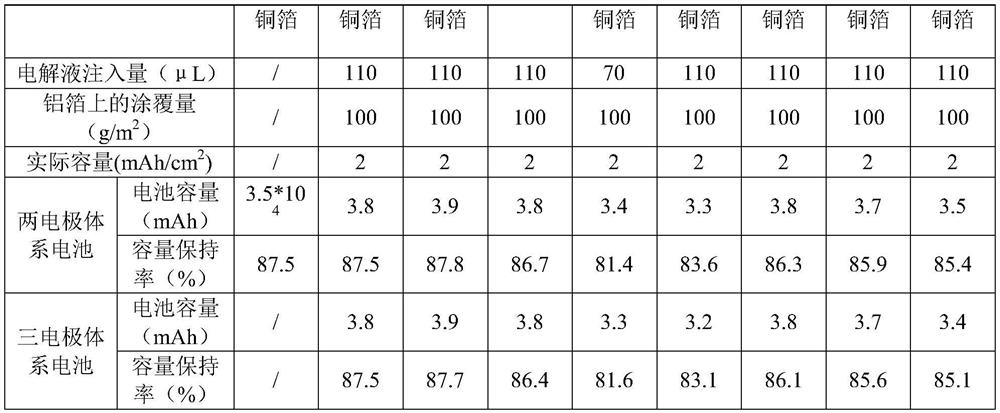Method for evaluating performance of soft package lithium ion total battery by using button type half battery
A half-cell, lithium-ion technology, which is applied in the field of evaluating the performance of soft-pack lithium-ion full-cells, can solve the problems of lack of limited connection, reduced data reliability, etc., to achieve good practicability, saving test resources, and high test accuracy. Effect
- Summary
- Abstract
- Description
- Claims
- Application Information
AI Technical Summary
Problems solved by technology
Method used
Image
Examples
Embodiment 1
[0034] A) Production of positive electrode sheet: NCM811 ternary layered material: carbon nanotubes: polyvinylidene fluoride in a ratio of 85:7.5:7.5 and then coated on 18μm aluminum foil with a coating amount of 100g / m 2 , at 3.2g / cm after coating and drying 3 Compaction at the compaction density of 1.2 cm in diameter to make a circular positive electrode sheet;
[0035]B) Making a negative electrode sheet: a 50 μm thick lithium sheet layer and a 200 μm thick copper foil are pressed under an argon atmosphere of 40 standard atmospheres to make a circular negative electrode sheet with a diameter of 1.4 cm, which is used as a counter electrode;
[0036] C) Assemble a button-type half-cell with a two-electrode system in the order of negative electrode sheet, diaphragm, and positive electrode sheet, and inject 110 μL of electrolyte into the button-type half-cell; Assemble a button-type half-cell with a three-electrode system in the order of 3-electrode, and inject 110 μL of elect...
Embodiment 2
[0039] A) Production of positive electrode sheet: NCM811 ternary layered material: carbon nanotubes: polyvinylidene fluoride in a ratio of 80:10:10 and then coated on 20μm aluminum foil with a coating weight of 75g / m 2 , at 3.0g / cm after coating and drying 3 Compaction at the compaction density of 1.0cm in diameter to make a circular positive electrode sheet;
[0040] B) Making a negative electrode sheet: a 55 μm thick lithium sheet layer and a 195 μm thick copper foil are pressed under an argon atmosphere of 100 standard atmospheres to make a circular negative electrode sheet with a diameter of 1.2 cm, which is used as a counter electrode;
[0041] C) Assemble a button-type half-cell with a two-electrode system in the order of negative electrode sheet, diaphragm, and positive electrode sheet, and inject 110 μL of electrolyte into the button-type half-cell; Assemble a button-type half-cell with a three-electrode system in the order of 3-electrode, and inject 110 μL of electro...
Embodiment 3
[0044] A) Production of positive electrode sheet: NCM811 ternary layered material: carbon nanotube: polyvinylidene fluoride in a ratio of 90:5:5 and then coated on 15μm aluminum foil with a coating weight of 125g / m 2 , at 3.3g / cm after coating and drying 3 Compaction at the compaction density of 1.4cm in diameter to make a circular positive plate;
[0045] B) Making a negative electrode sheet: a 45 μm thick lithium sheet layer and a 205 μm thick copper foil are pressed under an argon atmosphere of 20 standard atmospheres to make a circular negative electrode sheet with a diameter of 1.6 cm, which is used as a counter electrode;
[0046] C) Assemble a button-type half-cell with a two-electrode system in the order of negative electrode sheet, diaphragm, and positive electrode sheet, and inject 110 μL of electrolyte into the button-type half-cell; Assemble a button-type half-cell with a three-electrode system in the order of 3-electrode, and inject 110 μL of electrolyte into the...
PUM
| Property | Measurement | Unit |
|---|---|---|
| Thickness | aaaaa | aaaaa |
| Thickness | aaaaa | aaaaa |
| Thickness | aaaaa | aaaaa |
Abstract
Description
Claims
Application Information
 Login to View More
Login to View More - R&D
- Intellectual Property
- Life Sciences
- Materials
- Tech Scout
- Unparalleled Data Quality
- Higher Quality Content
- 60% Fewer Hallucinations
Browse by: Latest US Patents, China's latest patents, Technical Efficacy Thesaurus, Application Domain, Technology Topic, Popular Technical Reports.
© 2025 PatSnap. All rights reserved.Legal|Privacy policy|Modern Slavery Act Transparency Statement|Sitemap|About US| Contact US: help@patsnap.com



